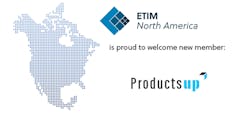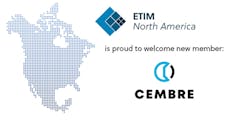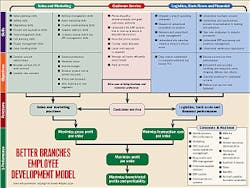This year’s Electrical Wholesaling Top 200 offered several important insights. The smallest distributor on the list had revenues of about $12 million, the lowest we ever remember seeing on a Top 200 listing. That’s because the biggest got bigger and branches belonging to larger organizations now dominate the industry numbers. The top 10 distributors have over 3,500 of what we estimate to be more than 9,000 total industry locations. The top 25 distributors on EW’s Top 200 have just short of 4,500 — almost half the industry’s locations. That creates many issues for larger organizations, and any distributors with a decent number of branches.
It’s tougher to drive uniform performance in branch organizations. It’s harder to create uniformity of service as operations become more remote and management layers get in the way of standardized performance without well-executed process documentation, standards and business systems. Expectations at the branch are most often different from headquarters and regions. The process also suffers from a lack of specific performance standards and processes as communicated by upper management to employees in regions and branches.
This is more critical than ever because the bigger you get, the more customers expect uniformity of performance from location to location. Let’s look at some applicable examples from outside of the electrical industry. Customers know what they are going to get with Wendy’s, McDonald’s, Starbucks or Marriott. Does a national account customer get the same treatment and performance from every location of a large national distributor, regional chain or even a large two- or three-state chain? In many cases, probably not. We hear about issues on national account performance all the time. Branches of national distributors can’t provide the same levels of performance, nor can different distributors that are part of a collaborative national account organization.
Let us switch your thinking for a minute to a service industry where uniform performance night after night is critical, so critical that if you don’t have it, you go out of business fast. Watch an episode of “Bar Rescue” on television and you’ll hear that thousands of nightclubs and bars go out of business each year. In March, we had a conversation with the show’s star: consultant and Spike TV series star John Taffer at the Las Vegas Bar and Nightclub show in Las Vegas. We asked about his wisdom in leaving branding till after he discovers what a staff could produce. He told us your brand is what you do. He is also big on creating standards with all his rescue clients. On most episodes, you’ll hear Taffer bellowing at owners that their businesses lack standards. Does yours?
To build and maintain your brand equity, you need to create consistent performance across outlets. Executing branch startups when acquisitions are unavailable requires standardized practices to bringing new people aboard. So does integrating a new branch’s personnel after an acquisition.
How do you create uniform performance? Create better branches by training more professional managers to run them and employees to work in them. That takes processes and systems to ensure uniform people development and performance. Here’s where we would like you to stop and consider a different way of thinking about branches to help them grow so “the tree” ultimately profits. Instead of thinking of branches as outlets to be harvested, what about feeding them first?
Branches are part of a tree. They are fed solid nutrients and water in the form of “sap” by the trunk and root system. Branches reach for light to complete the process of photosynthesis in order to flower and bear fruit. The process is amazingly similar in a business. You need to feed people at branches with the ability to identify and satisfy customer needs (reach for the light). You also need to feed them process and factual knowledge (provide solid nutrients). And you need to inspire them (infuse water) to motivate action. So how and what are you feeding your branches?
Feeding the branches and the people in them with the right stuff is no small task. There are issues in branch management and employee development to overcome, for sure. There is a shortage of ready to hire, knowledgeable people in the industry, so organizations must develop people to do their jobs, advance to higher positions and grow the business.
One issue causing this problem is that the training programs now in use in the electrical industry don’t always do a good job of providing content that will help develop the specific jobs skills that branch managers, field salespeople and inside sales personnel need at the branch level. Some of our distributor clients have told us and we have learned from the years we spent working for electrical distributors that:
- Companies need to know the skills required in each position.
- Companies need to source training courses that develop the right skills.
- Content is not well organized by position type by any source.
- Product content dominates training agendas, business practices are secondary and often not tailored to a specific business.
There are several reasons why online courses are not always effective in providing this type of training:
- Service people taking the courses are interrupted frequently, hindering concentration and learning.
- Online courses may not teach what a company wants their people to learn or in the desired sequence.
- Some topics don’t lend themselves to online learning; they are better executed in person.
- Online learning is only as good as a manager drives, inspects and enforces, and top management demands. Too much of it is “voluntary” and may not be completed.
Other challenges exist in any training effort, whether it be online or in person. Scheduling is a big issue. Service people need to be on the job, and it’s difficult to get many together at once for a course. Many employees are from two-earner families or they are single parents so they can’t attend before or after-hours instruction. Smaller distributors have additional challenges when they want to run training sessions. While larger service staffs can run multiple sessions and stagger attendance, small branches find it more difficult because they might not have someone to cover for an employee in a training class.
Another challenge is the quality and format of product training from manufacturers. Distributor training pros claim it’s hard to get manufacturers to conform to an effective format for product training. But few have created one and asked for conformance.
Job Function Training
From our experience and interviews with distributor executives, we have found that when electrical distributors are breaking in new employees, most often they don’t have a documented approach. Part of the problem is that few organizations create work instructions for every task, and they often lack a documented and recorded sequence of self-training, supervisor and instructor training. Few have checklists of tasks for breaking in new employees.
To effectively train staff, branch managers must have working knowledge of all management functions and every job. Fortunately, branch manager training is one of the few comprehensive position training courses offered in the industry. That being said, many larger distributors have separated outside sales operations from branch service operations. This requires separate sales management training versus operations and service training.
A Model for Better Branch Performance
After talking to several owners and managers, we developed a model for branch performance. This is our first attempt, and we will be adding to it as we go. As you can see at the bottom of the chart we started with the end goal, maximizing branch total profits and profitability, and worked our way back to the skills required by function to drive financial performance. In future articles of our “Better Branches” series, we’ll break the skills down by position and relate them to business process execution.(We have made some assumptions on corporate and regional responsibilities on the chart and recognize this will vary among organizations.)
Meanwhile, we encourage educational content providers to start offering their content by position type for distributors. Many distributor managers and training professionals are confused about what courses are appropriate for different positions as they try to develop a sequence of courses for each position.












